The correct design of the ceiling allows you to create a harmonious design, but in addition to the flow itself, it is necessary to properly organize lighting. And this is an even more difficult task – you need to take into account the need for light, and also choose the location of lights on the ceiling so that it all looked beautiful, organic and did not strain the eyes.
Conteúdo do artigo
A little theory
In recent years, lighting in houses and apartments usually consists of two components – a chandelier as the main source of counting, and small spotlights that create a certain atmosphere or additionally illuminate some areas in the room. In some cases, more wall lamps and/or table lamps, floor lamps are added. But the basis is usually ceiling lighting.
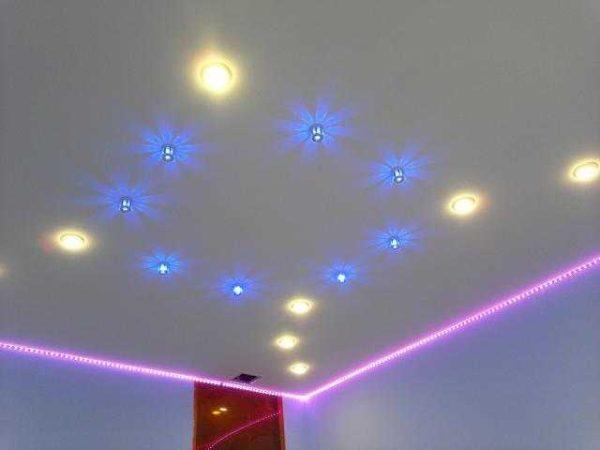
Traditionally, the place of placement of the chandelier – strictly in the center of the ceiling. From this rule deviate very rarely – too hard then to create a harmonious design. The exception – a combined space in a studio apartment or kitchen-living room. In this case, the chandelier (usually one) is placed in the center of one of the zones, the rest are illuminated by spotlights or other light sources. To choose the location of lights on the ceiling in this case should take into account the design and geometry of the room. And this is not so easy.
Rules for placing spotlights
The location of spotlights on the ceiling is a matter of fantasy and taste, but you should not neglect the technical nuances. First, they should be placed taking into account the required illumination of different parts of the room: more light is usually needed above the table, maybe – over the recreation area, etc. Although, if necessary, “finish” the missing brightness can be with the help of floor, table or wall-mounted options. Secondly, install spotlights should take into account the safety requirements. This is especially true for stretch ceilings. They are made of materials that are sensitive to temperature, and since most of the lighting fixtures are heated, this must be taken into account.
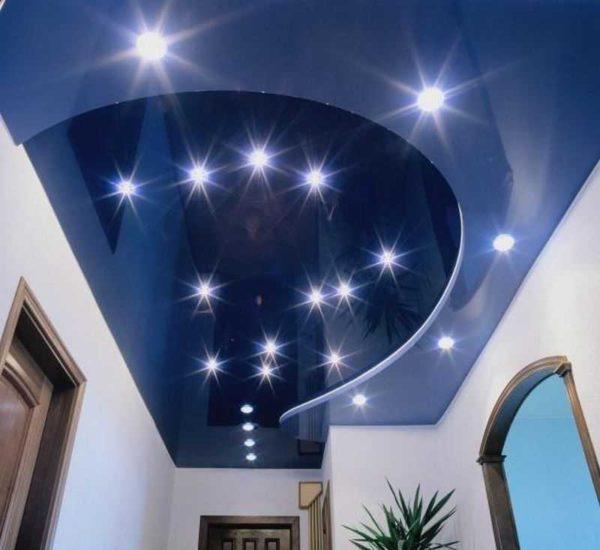
Recessed spotlights are also called spots. This name is not so widespread, but also occurs.
Here are the norms for installing spotlights on the ceiling:
- When placed along the wall, the minimum distance is 20 cm. If placed closer, the light is dispersed poorly, and there is also a possibility of “overheating” the nearby walls.
- The minimum distance between two lights – 30 cm, but in general, it depends on the design, type of installation, the material from which the ceiling is made.
In general, these are all general restrictions. They apply to plasterboard and ordinary – whitewashed or painted – ceiling. Only the stretch ceiling has its own peculiarities. We will talk about this further.
Features of the use of recessed lights on stretch ceilings
The main nuances are associated with the fact that the materials from which stretch ceilings are made do not tolerate strong heating. Therefore, there are restrictions on the maximum power of the lamps used:
- on the PVC film put
- incandescent lamps up to 40 W;
- halogen – up to 20 W;
- on satin
Despite the fact that the power of the recommended lamps are different, the illumination will be almost the same, because the light halogen give more.
Another type of lamps that are used to illuminate the stretch ceiling – LED. There are no power restrictions here – they practically do not get warm. But there is another “but” – to power such lamps requires a special adapter, and here he is warm. But the good news is that it can power quite a large number of bulbs. Well, and place it better not on the ceiling, and in an accessible place – for easier repair or replacement.
What else can be used to illuminate the ceiling
The next type of lamps – fluorescent. They are used very infrequently – the look of them, to put it mildly, “not quite”, and the dimensions are solid. Only spoil the view. They can be mounted behind the stretch ceiling on the walls. In this case, the effect is very interesting – diffused illumination is more intense at the walls, smoothly converging to a minimum in the center.
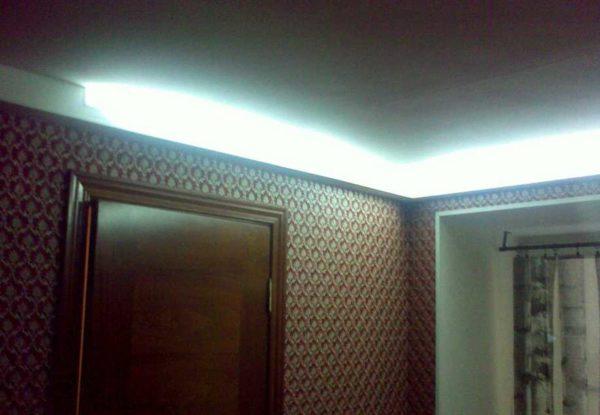
In addition to fluorescent lamps, there are long LED lamps. They can also be used for concealed backlighting. This option is even better. First, because LEDs have a longer service life, secondly, they practically do not heat, thirdly, they give a steady stream of light without flickering inherent in fluorescent light sources. The disadvantages of LED lighting are two. The first has already been voiced – you need special power supplies. The second – the high price of the lamps themselves and power supplies to them. But you can create very interesting compositions, which with other sources of light to organize difficult.
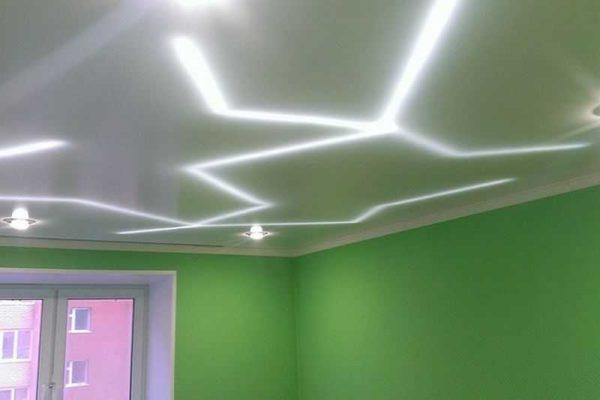
There is also their subspecies – economy lamps. They have a base like the usual ones, with the same power consumption give more light, but have large dimensions and do not have the ability to focus the flow of light.
What else can be used to illuminate the ceiling – neon tubes and LED strips. With tubes to work quite difficult, but LED strips can be connected independently. Thanks to their flexibility, you can create interesting compositions.
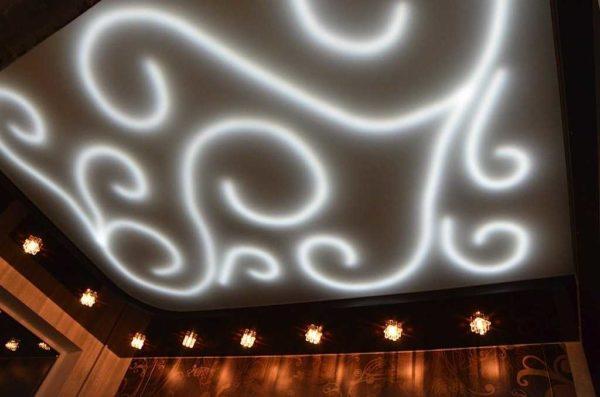
There is another requirement for the location of lights on the ceiling from the film – the minimum distance from the light source to the seam – 15 cm. Closer is not possible, since the joint can separate when heated.
How to calculate the required number of spotlights
When developing a scheme, there is always a question: how many lamps are needed. In general, it is believed that the lighting of one square meter of floor area requires 20 watts. When calculating, you need to take into account what power of lamps you plan to use. If it is 30-35 W, it turns out that one lamp can illuminate 1.5 square meters (30 W / 20 W/m2 = 1.5 m2). Then divide the area of the room by 1.5, you get the number of lamps that will need to be installed for normal illumination. In this case, the light will be enough for full lighting.
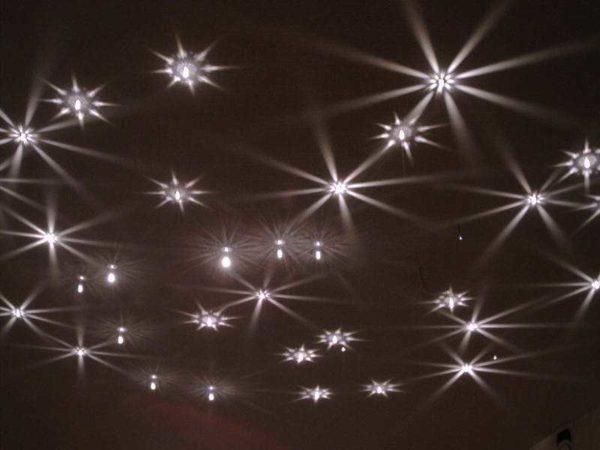
When drawing up a scheme of placement of lights on the ceiling, this number can be slightly adjusted in both directions, adjusting for the type of room. For example, for the bedroom, the number can be reduced – here you do not need too bright light, and for the living room, corridor can be increased – here it is just better to have some excess. However, in this case it is desirable to turn on the lights in parts – it is desirable to vary the degree of illumination. There should be at least two options: full and partial lighting. For this purpose, the lamps – through one or some other scheme – are connected to two keys of switches.
When using incandescent lamps in spotlights, you can install a dimmer, which will allow you to smoothly change the brightness of lighting by turning the knob. In general, there are a lot of options. And we have not yet reached the schemes of location of spots on the ceiling.
Location of lamps on the ceiling
For each room, the placement of lamps is developed separately. It is necessary to take into account the geometry of the room, the location of windows, the needs of different zones in the room. And all this should look beautiful. In general, quite a complex task and pick up can only be specifically on the spot.
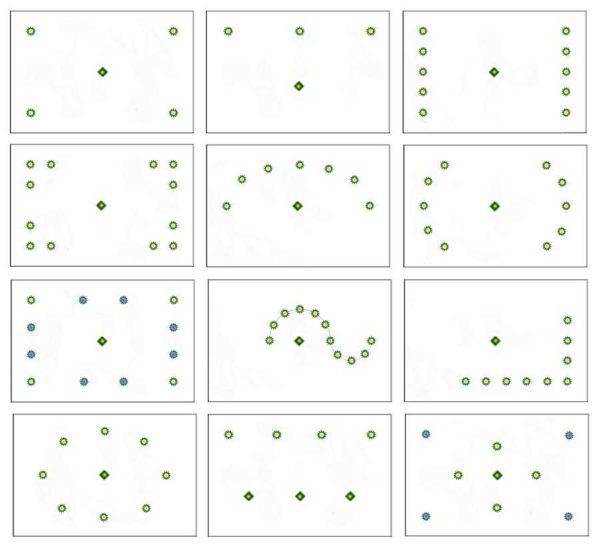
The main options for placing backlighting provide for the presence of a chandelier in the center. Spots are selected in the same style or neutral, not attracting attention.
In some interiors, chandeliers are not used (in small corridors, bathrooms, etc.). In this case, the number of necessary lamps is calculated according to the above formula and can only be adjusted upward, otherwise it will be dark. Some examples are schematically depicted in the photo below.
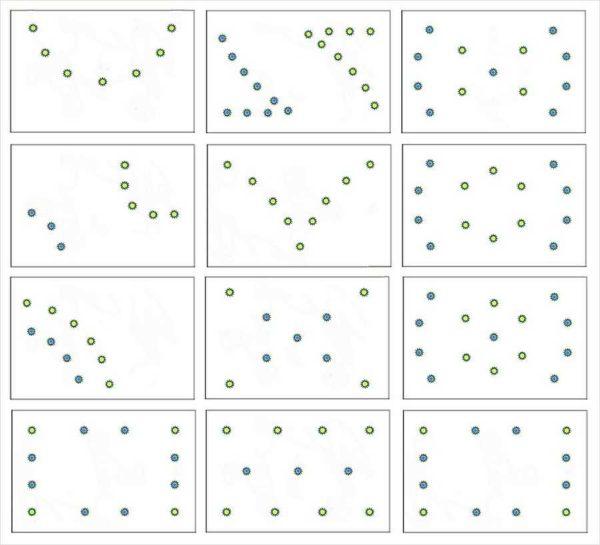
As you realized, the process is creative, but there are certain recommendations for the location of lights on the ceiling for each of the rooms. These are not rules and, if desired, they can be broken, but they are formulated on the basis of experience, so there is a rational grain in them.
In the bedroom
In the bedroom, the atmosphere should be relaxing and bright light is usually unnecessary. It should be soft, unobtrusive, warm. Therefore, choose lamps that give light slightly yellowish, but not bright white and not with a blue tint.
- Fancy curls in one of the corners
- Often use an oval
- Combination of different types of lighting
- Chandelier in the center, square spotlights lined up along the wall
The arrangement of lamps on the ceiling in the bedroom is more often made in the form of a circle or an oval. Sometimes the spots are lined up in a straight line along the wall opposite the bed – if there is a TV hanging on it. For a laconic design in a modern style, in the style of minimalism or hi-tech, the classic scheme is suitable – the chandelier in the center, spotlights are lined up along the long walls.
In the living room
In the living room, multivariant lighting is required. At some moments it should be bright, at other times – subdued, sometimes, in general, requires semi-darkness. All this can be realized with the help of recessed or overhead spotlights. As already mentioned, they are divided into groups and connected to different keys of the switch. In other situations put a dimmer, which changes the brightness of the glow of the lamps.
If the living room has two zones, their separation can be emphasized by different lighting. You can choose not only different in shape schemes for installing lamps, but the devices themselves can be different, to give streams of light of different shapes.
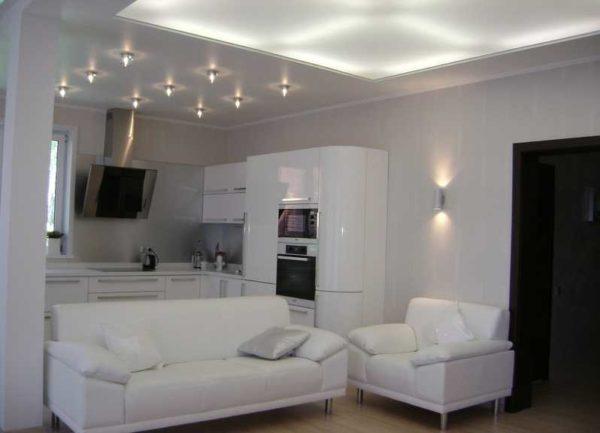
If we talk about what to choose the location of lights on the ceiling, it is largely dictated by the general style of room design. For romantic styles are more appropriate ovals, circles, curved lines, for more rigid – modern, high-tech, minimalism – is better suited linear arrangement, but along the walls, in the form of the letter X or something else – it is already look at the situation.
Another tip: in small rooms should not realize too complex schemes for installing spots. They are good in a large and spacious room. In a small one, it is better to choose a simpler option. Visually raise the ceiling a little will help nested circles, ovals or squares. The effect will be enhanced if you use spotlights in the middle of a slightly smaller size than on the outer perimeter.
Quarto das crianças
Children’s room is a rather difficult room to decorate, as it will need even more diverse lighting. The child will need to study and this area needs bright light. There is also a play area, in it the illumination should also be sufficient, but a lot of light is not always needed. And the third degree of illumination – when the child will be preparing for sleep. At this time requires a subdued soft light. This is such a difficult task will have to solve choosing the location of lights on the ceiling for a child’s room.
If the ceiling is planned in two or more tiers, it is logical to place spotlights along the border of the two tiers. It looks quite organic. If the ceiling will be flat, you will have to choose from existing schemes or invent your own.
Cozinha
The location of lamps on the stretch ceiling in the kitchen is subject to all the same rules – in some areas the lighting should be brighter. In this case, an island of bright light is usually made above the table. Here you can hang a chandelier (or even several chandeliers) on long cords directly above the table.
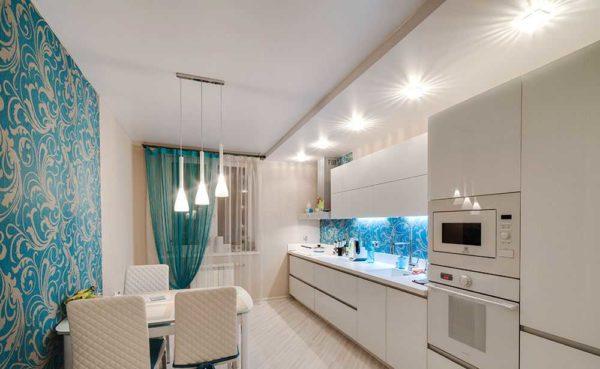
The second common option – the line of installation of soffits on the ceiling repeats the contours of the kitchen set. Only in this case, the lights should be moved out centimeters 15-20 deep into the room from the edge of the furniture. Then the light will be dispersed more evenly.
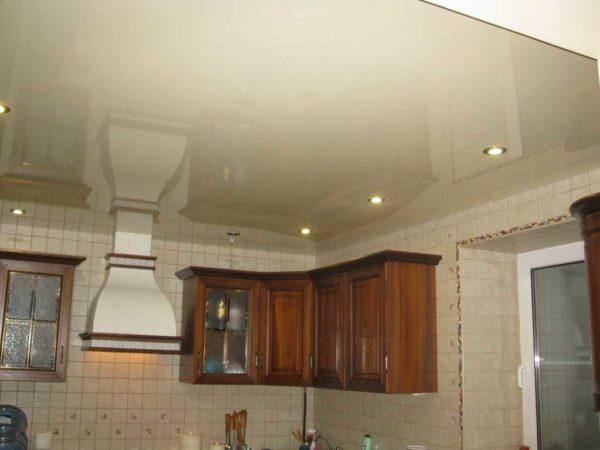
In general, the choice of the location of lights on the ceiling and here depends more on the style of the room as a whole and on the tastes of the owners. If you want to add interior softness, chamber, choose more rounded schemes. If you like laconism more suitable geometric patterns. You can also play with the size and type of lamps. A few photos of interesting options for the location of spotlights for the kitchen you for inspiration.
Bathroom
Approach the choice of lamps in the bathroom should be carefully: they should have a high degree of protection – they should not be afraid of vapors and splashes. And the choice of location depends on what other light sources you plan to use.
In small-sized ordinary bathrooms, even if combined, you can not accelerate much – the area is too small. Then usually above the bath or shower cabin set two or three lamps and a few pieces on the rest of the ceiling area. To make this scheme not seem too simple, you can choose interesting fixtures or use two types that give beams of light with different patterns.
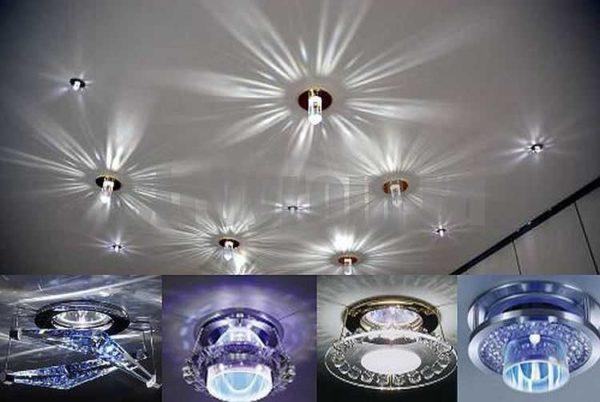
If soffits in the bathroom will be installed evenly throughout the area, in the area of the mirror will need additional lighting. Otherwise it will be too dark there. Another option is to add a couple of lighting points in the right place. This should be enough, although for “delicate” operations such as beating or “work” with the face, directional lighting on the wall is still more suitable.
- An oval or circle is ideal
- In small rooms, you can’t get too fancy.
- Moisture-proof luminaires
- Plus wall lighting for maximum convenience.
Corridor and hallway
Only some new buildings can boast a really comfortable and good corridor. In most cases, however, the corridor is narrow, small and cramped or long and awkward. It can be straight or in the form of the letter “G”, but differs in that it is very difficult to think of something clear for its normal design. In corridors, the arrangement of lamps on the ceiling is usually linear – along the walls on one or both sides, in the form of the letter “X”. Rarely you can meet a curve like the letter S.
- Complex designs can be made in relatively spacious hallways
- Interesting lamps will help to diversify the interior
- On the perimeter or in the middle along – the two most common ways
- Seeming chaos will help to make the design more interesting
In square hallways usually mount spots along the perimeter, rarely here make complex shapes. Still, simple shapes look better on very small areas.

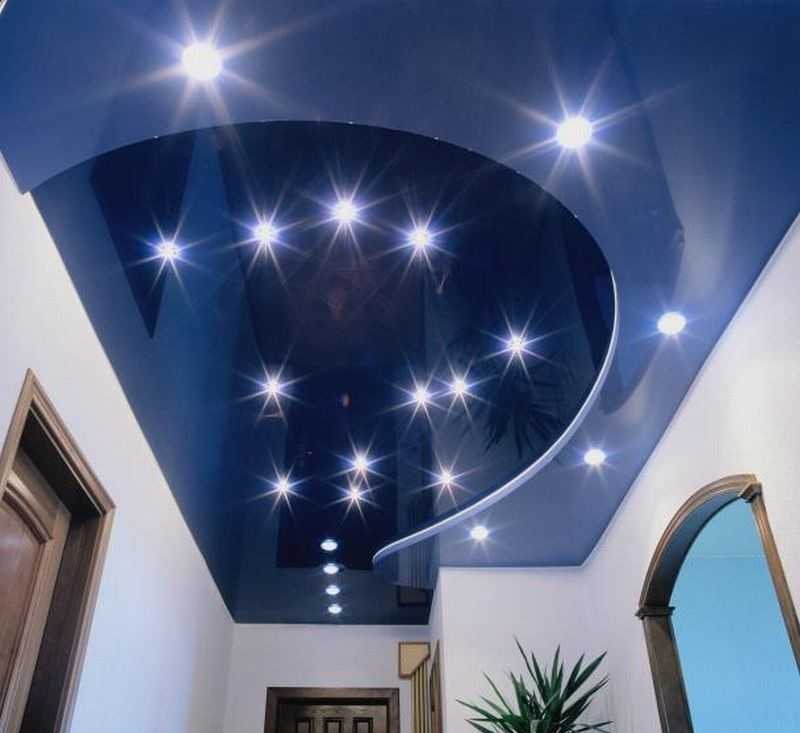
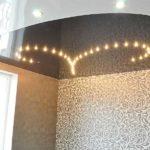
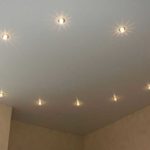
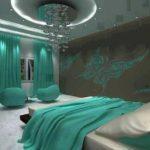
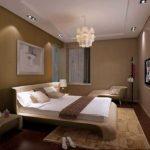
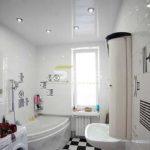
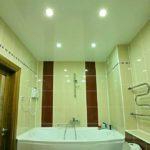
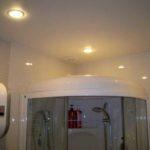
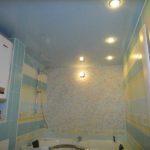
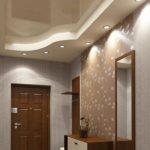
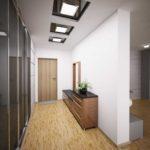
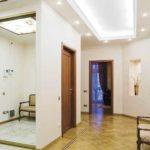
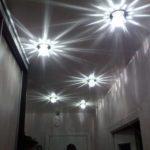

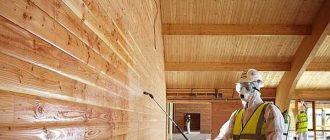
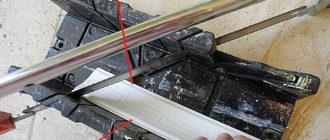
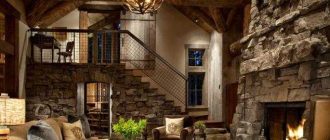
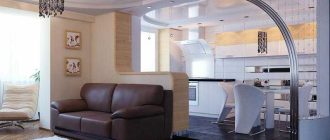
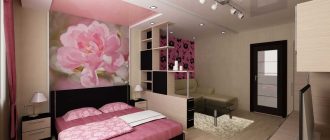
I remember when I was setting up my apartment. I went for LED strips and some funky pendant lights. Just had to plan the layout first, then drill some holes. It’s all about the vibe! Definitely brightened up the place and made it feel cozy.
Totally get that! I did something similar when I moved in. I strung up fairy lights and added cool wall art. Made a world of difference! Just like you said, it’s all about creating that vibe. My place feels like home now. Vibes are everything!
I recently tried to set up some ceiling lights in my living room. Honestly, it’s a bit tricky getting the spots just right. I used a level and tape measure to line everything up. Ended up being super happy with how it turned out—really brightens the space!